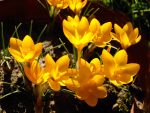Ankara crocus is a perennial plant and a member of the iris family, Iridaceae, that also includes gladiola, freesia, and crocosmia. It is endemic to Turkey, Pakistan, and Afghanistan  where it grows on dry hillsides. Three to four grass like leaves grow from each corm in late winter to spring followed by 2-3 long slender 6-petaled flowers. The flowers are cup-shaped, 1′ long, and have bright yellow petals sometimes touched with bronze. The cultivar, ‘Golden Bunch”, produces 5-10 flowers per corm. Ankara crocus is an excellent choice for a rock garden or grassy area but should not be planted in area such as lawns that need mowing before the foliage matures in spring. The genus name, Crocus, is from the Greek word κρόκος, krokos meaning thread and refers to the appearance of the stigmas. The specific epithet, ancyrensis, refers to Ankara, the capital of Turkey and country where the plant is endemic.
where it grows on dry hillsides. Three to four grass like leaves grow from each corm in late winter to spring followed by 2-3 long slender 6-petaled flowers. The flowers are cup-shaped, 1′ long, and have bright yellow petals sometimes touched with bronze. The cultivar, ‘Golden Bunch”, produces 5-10 flowers per corm. Ankara crocus is an excellent choice for a rock garden or grassy area but should not be planted in area such as lawns that need mowing before the foliage matures in spring. The genus name, Crocus, is from the Greek word κρόκος, krokos meaning thread and refers to the appearance of the stigmas. The specific epithet, ancyrensis, refers to Ankara, the capital of Turkey and country where the plant is endemic.
Type: Perennial corm
Bloom: Late winter to very early spring
Size: 4-6″ H x 6″ W
Light:Full sun, tolerate light shade
Soil:Average, medium moist to dry, well-drained
Hardiness: Zones 3-9
Care: Do not cut foliage until yellow
Pests and Diseases: Rabbits, rodents, andother small mammals eat the corms.
Propagation: Division of offsets, seed
Companion Plants:Other early crocuses, hellebores, glory of the snow, pansy, Iris reticulata
Outstanding Selections: ‘Golden Bunch’
Photo Credit : Ghislain Wikimedia Common